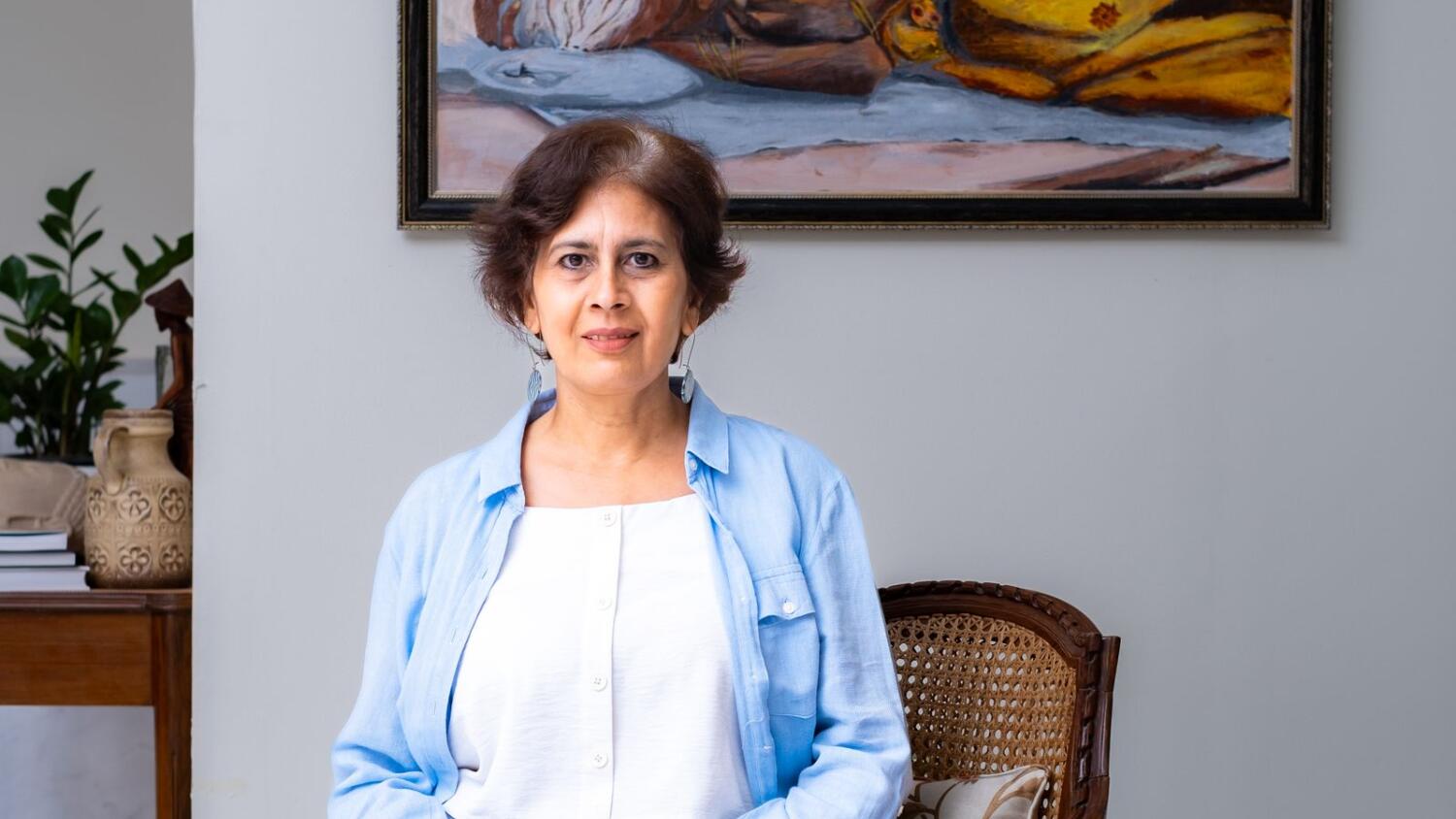A sustainable artist from Abu Dhabi discusses how the UAE has influenced her work.
- byAdmin
- Jul 1, 2024
- 11 months ago

It is challenging to neatly classify Vandana Sudhir's artwork into any one category. Does it follow the tenets of realism? Does she create abstract art? The artist from Abu Dhabi has successfully experimented with a wide range of mediums, but the unifying theme in all of her creations is a celebration of humanity and how we respond to pain and joy. As a fervent supporter of sustainability, Sudhir combined sustainability and tolerance, two concepts that are central to UAE public policy, in his COP28-themed paintings. Sudhir, who has studied psychology and child development, goes into great detail about her creative process and how impermanence characterises her work in an interview with Khaleej Times. Excerpts edited from an interview:
What attracted you to the arts?
My interest in painting was sparked by a variety of events rather than just one. When I was four years old, I can still clearly remember looking at a book of abstract art images. I used to be able to enter another world just by gazing at the abstract art, the cubes, and the colours since the images were so beautiful. The way that fictitious pictures might gaze at me so intriguingly with only a few colours added here and there, at strange forms, and fitting into the most predictable areas fascinated me.
I also remember a five-year-old painting competition at my school. I was among the youngest students in the class at school. It was our task to imagine a setting that would depict a wet day. I sketched what I could, but my picture was smudgy and grey, lacking in depth because I was used to seeing rain and puddles. I choked with amazement when I watched more experienced and mature painters create vibrant portraits of people in brightly coloured clothing and umbrellas walking down the street; they were all so prepared with the subject and the characters that they used to fill their blank pages.
When I was awarded second place at the competition's conclusion, I was blown away and recall crying in shock. That little encounter, though, let me see that art wasn't necessarily about vivid imagery or conventional shapes and characteristics. It involved using one's imagination. It has to do with the concept you presented.
Your artwork displays a variety of styles. Friends has an abstract appeal, but Timeless Essence is as realistic as it gets. How do you move between all these many styles? Does the topic drive style, or the other way around?
I haven't limited myself to any one method, and this contrast boosts my creative energy. It gives me the ability to openly express a variety of feelings, no matter how ethereal they may appear. To avoid becoming bored, if given the option, I generally select a different style or medium each time.
In addition, art is thriving everywhere. It's in the withered, decaying, textured leaf on the ground as much as it is in a piece of Danish-designed furniture, if you start to look about. Every time I see anything inspiring around me, I have an inner desire to produce something creative. It is what determines my preferred style for a certain piece of work.
For instance, the image of a guy relaxing on a bench served as the inspiration for the life-size portrait of the woman in Timeless Essence. Friends' abstract aesthetic came about because I simply couldn't bring myself to portray five contented humans interacting realistically. It would get really monotonous. It would be very cliched.
Finally, I constantly seek for innovation and originality, and as a human being, it is also what I stand for. My living decisions are as unconventional or distinctive as my artwork, and vice versa.

Expression is what art is. We use it as a channel to express our emotions to other people. Understanding how we — and others — think, behave, and feel is made easier by psychology. My awareness of the world around me therefore contributes to the development of my artistic sensibility and gives my topics a personal touch.
Looking back, I realised that I became a teacher because of my degree in psychology and child development. I've been a teacher at several different levels, and I've watched how my own behaviour observation has grown. This gave me the opportunity to pick how I wanted to represent my characters and to grow in my empathy for individuals with various abilities and cultures.
Your art has a lot of feminine shapes. Do you find the celebration of femininity to be significant?
Indeed. I wish to emulate the traits of other women that inspire me in my artwork. I believe that the modern woman is capable of becoming anything she desires and is prepared to advocate for herself. Women are shown in my collection of International Women's Day artworks as emerging as strong-willed, tough, and brave.
In my opinion, everyone is embarking on a path of self-discovery. What I represent about women is not their appearance or anatomy. I'm always looking for the soul that stands in for them, their emotions, and their journey through life. As you can see, human development occurs in two different ways. Genuine, compassionate, and human values-aware ladies are people I can relate to readily. Naturally, I'm happy to be able to depict ladies.
You have consistently supported sustainability. Why does that matter so much to you?
The context has a major role in the solution. Among other places, I grew up in India, the birthplace of Mahatma Gandhi. Indians are taught about the disparities in our society and the reality that some people suffer from extreme lack of the same goods that others may take for granted from a very young age. As a culture, we are cautious and thoughtful shoppers. As a result, seeing excessive consumption hurts. There should be enough resources for everyone on Earth if people use them wisely. And it holds true not only for tangible products but also for things like our specialty arts, distinctive cultures, and community resources. My general view of globalisation is that circumstances like as the COVID-19 pandemic and climate change have compelled us to consider the ways in which we might maintain our interconnectedness and interdependence. They also showed us how to be frugal with our resources. We now more than ever need to unite and share ideas, cultures, and natural and man-made resources while preserving our individuality.
I used to get great satisfaction from doing workshops on resource conservation. I worked on a series of paper tearing and tidbits art with The British Council during one of my early sessions. Even now, utilising leftover textured handmade paper pieces to make art is one of my favourite mediums. An example would be the two pieces of art I displayed at COP28. I wish to continue, investigate, and expand this kind of work. Here, I can make work that is meaningful, sustainable, and has a purpose by utilising intriguing and readily accessible textures, colours, and materials. And I hope to do that more often in the future.
In addition, I keep researching sustainability since I am privileged to collaborate with a group of artists in the United Arab Emirates who share my commitment to the topic. Last year, six of us artists worked together on the sustainable art display, Existence, for the COP28 summit.

Given your constant mobility, how does the concept of impermanence manifest itself in your work?
For me, impermanence encompasses more than simply the idea of moving physically every few years. In an ever-changing environment, reinventing myself and broadening my skill set have always been a part of who I am. I treasure living in a place where, free from expectations or judgement from others, I may choose my own path every few years of my life and develop according to the possibilities I'm given. As a teacher, I have found this to be quite effective. I have experience working with a variety of school boards, cultural backgrounds, normal and talented children, as well as students on the autism spectrum.
As an artist, I've also found success with this. The centre of stability and serenity in the middle of the craziness of frequent travel is my creative space and spirit of adventure. In the middle of the uncertainty and bustle of unfamiliar surroundings, I eagerly anticipate fresh starts. My studio helps me focus since I frequently have ideas for things I've been planning for a while, and a fresh, peaceful place gives me the break I need to get creative. When I am moved, my daily practice does suffer, but I am certain that it is crucial to take stock and start over.
The variety of civilizations I have experienced is reflected in my artwork. I have a piece that illustrates how humans and environment are interconnected. Timeless Essence honours bravery and resiliency in the face of difficulty. Like art, impermanence is ubiquitous. It is evident in the difficulties my daughters encounter as global citizens and in the faces of the migrants. My transience is revealed in the common stories of a group of ladies who are all outsiders and in the young people who are looking for friendships and companionship among a heterogeneous population.
Your pieces of art with COP28 and Tolerance and Sustainability as themes speak to important issues facing the UAE. How were these pieces of art conceptualised by you?
My perception of a country that thrives on economic growth while developing continuously and with sensitivity to sustainability serves as my source of inspiration. Its individuals are doing excellent work, and the society is collaborating to achieve the same peace, harmony, and prosperity that nature seeks. I chose to dedicate the artwork to the United Arab Emirates because I am in awe of the skillful and capable leaders that have built the platform to enable and empower their inhabitants to live happily while fulfilling their own ambitions. My work on Tolerance and Sustainability is dedicated to the country that served as my inspiration.
This work is divided into two halves. In the first, the UAE's founder is shown against a mangrove backdrop. The mangroves produce thick, tangled roots and offer a variety of fish, sea turtle, and bird species a rich natural home, enhancing the ecosystem and enabling symbiotic living and flourishing for everyone. In a similar vein, the UAE's visionary leadership has established a sustainable ecology. It fosters compassion and empathy in all of the locals. This setting has made it possible for many communities to thrive, which is necessary for success, understanding, and collaboration. In the same way as mangroves develop networks, tolerance builds bridges. Mangroves are shown in this work as a symbol of serenity and harmonious cohabitation. This is in line with SDGs 8, 15, and 16 of the UN.
The Mother of the Nation is described in the second section as planting the seeds of a magnificent nation using sustainable bits of paper. From the moment the Emirates unified, there has been constant effort on several fronts. Sheikh Zayed, known as the Father of the Nation, possesses the foresight to see beyond the present and utilise the resources at hand to construct a sustainable future. In this picture, the nation's mother, with her knowledge, skill, and labour, is weaving his aspirations into the fabric of the country. The UAE flag's tiny colour pieces stand for every modest or large action that has advanced the nation under the leadership of its leaders. For this piece of art, I used materials found around the house to cure the planet.
Post a comment
Hot Categories
Recent News
A sustainable artist from Abu Dhabi discusses how the UAE has influenced her work.
- Jul 1, 2024
- 11 months ago
Daily Newsletter
Get all the top stories from Blogs to keep track.




0 comments